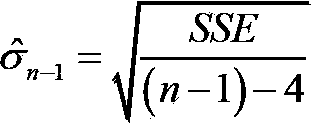Parity vector method-based double-satellite failure recognition method
A technology of parity vector method and fault identification, which is applied in the field of satellite navigation and positioning, and can solve problems such as misjudgment, missed judgment, and fault offset offset
- Summary
- Abstract
- Description
- Claims
- Application Information
AI Technical Summary
Problems solved by technology
Method used
Image
Examples
Embodiment
[0088] figure 1 The flow of the invention is given. The specific method is as follows:
[0089] (1), remove satellite i from existing n satellites, initially i is 1;
[0090] (2), carry out fault detection to the remaining (n-1) satellites, and the judgment amount of fault detection
[0091] σ ^ n - 1 = SSE ( n - 1 ) - 4 - - - ( 13 )
[0092] Calculate the fault detection threshold σ for (n-1) satellites T,(n-1) :
[0093] σ T , ...
PUM
 Login to View More
Login to View More Abstract
Description
Claims
Application Information
 Login to View More
Login to View More - R&D
- Intellectual Property
- Life Sciences
- Materials
- Tech Scout
- Unparalleled Data Quality
- Higher Quality Content
- 60% Fewer Hallucinations
Browse by: Latest US Patents, China's latest patents, Technical Efficacy Thesaurus, Application Domain, Technology Topic, Popular Technical Reports.
© 2025 PatSnap. All rights reserved.Legal|Privacy policy|Modern Slavery Act Transparency Statement|Sitemap|About US| Contact US: help@patsnap.com



